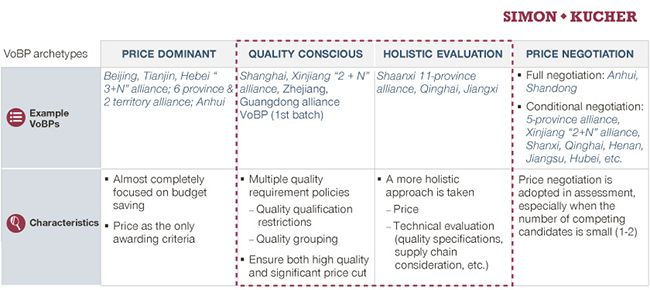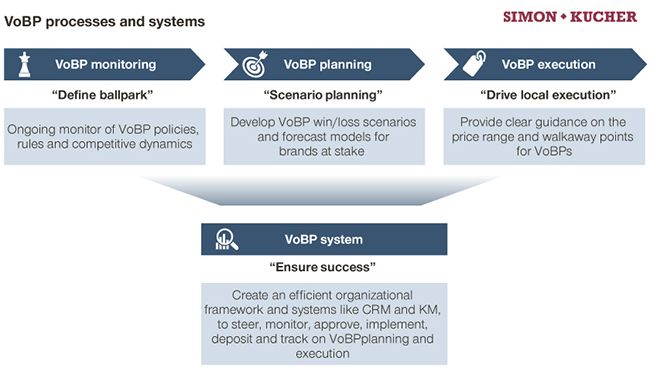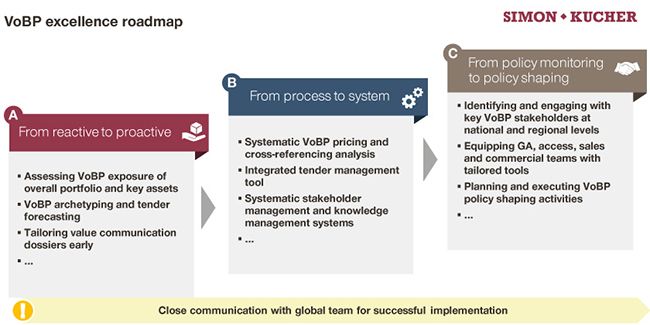Improving Readiness for Volume-Based Procurement in China
Volume-based procurement (VoBP) has been gathering momentum in China, both at national and regional levels. Major pharmaceutical players stand to see large impacts on their branded generics portfolio, and need to move fast to improve organizational and system readiness.
VoBP as the new normal for branded generics in China
Volume-based procurement (VoBP) is a series of drug procurement policies carried out in China, aimed at encouraging generic substitutions and bringing down the cost of drugs that have passed their exclusivities.The rollout of volume-based procurement in China began in 2018, featuring stiff competition and steep price cuts for mature drugs. More recently, VoBP has unfolded at both national and regional levels, with broadening scope, faster pace, and greater price pressure.
At the national level, the results for the 5th round national VoBP were released on June 23 2021, and with 61 drugs included, were broader in scope than previous rounds. The magnitude of the cut also broke records with an average of 56 percent. Of the 251 products that won the tenders, most came from local companies, with just 11 from MNCs. However, unlike previous rounds, injectables became the main focus, accounting for almost half of the drugs included.
In parallel, the pace of regional VoBPs has accelerated. Rolled out in the second half of 2019, over 40 regional VoBPs have been carried out so far, covering all provinces across China. More recently, cross-province alliance VoBPs have emerged to improve bargaining power.
New challenges for pharma companies
Complementary to national VoBPs, regional VoBPs mainly focus on drugs that are not covered by national VoBPs, including non-GQCE products, injectables, and biologics, and pose a different set of challenges to major pharmaceutical players:
- Diverse rules, short notice, and added time pressure
VoBP tendering policies could vary greatly across regions. For example, many VoBP listing takes into account region-specific drug utilization, budget impacts, and local competition. Besides, winning rules range from pure price-based tendering at one end of the spectrum, to quality grouping, overall scoring, and price negotiation at the other. At the same time, almost all regional VoBP feature short notice and lead time, creating added time pressure for VoBP participants. - Significant price pressure and market access impact on the region
On average, a price cut of over 50 percent is expected to win regional VoBP, which is in line with the national price cut average. In exchange for price cuts, the volume commitment for winners at the regional VoBP is roughly in line with national VoBP, ranging from 50 to 75 percent. Additional restrictions on the remaining volume allocation makes the situation more challenging for VoBP losers. For example, some regions require mandatory price cuts for products opting out of VoBP, while others specified that the procurement volume of the losing products cannot be higher than the winning ones, and cannot exceed their volume from the previous year. In a recent Guangdong-led 13-province alliance VoBP, the rules went on to specify that “in principle hospitals should continue to procure the winning products for the surplus volume”. - Cross-regional price referencing
Price referencing is another powerful force for VoBP products. In fact, price referencing mechanisms are widely adopted in regional VoBPs as winning criteria, with many regional VoBPs having explicitly required “Price not higher than national bidding price.” Winning prices of regional VoBP are publicly available on the government “sunshine platform” and are visible nationwide. For some regions like Zhejiang, price referencing is applicable even before a contract expires, meaning price referencing could now be retrospective and impact previous tenders. As a result, a price cut in a certain region could undermine the price potential in other strategically important regions, and may even trigger national price erosion.
Improving VoBP readiness: strategic thrusts 3+1
Our experts at Simon-Kucher have identified three key areas for pharma players to improve their VoBP readiness:
- From reactive to proactive
Pharma players should anticipate the likelihood and future exposure of their portfolios to VoBP by mapping out LoE dates and the competitive landscape of portfolio products, identifying key regions with VoBP exposure by sale, volume, and urgency etc.
This involves systematically collecting existing regional VoBP information, grouping regions into different archetypes, then identifying the key characteristics and trends of key archetypes, and planning VoBP strategies tailored to the different archetypes. Accordingly, value communication dossiers should be prepared early on, by assembling concise value messages and stories to be communicated with different sets and archetypes of key stakeholders.
Click to enlarge

- From process to system
Standard VoBP processes and signoff procedures need to be introduced; besides that a more systematic approach should be considered to embed those into the organization.
We have been working with leading pharma players to develop a central system with integrated CRM and knowledge management (KM) to improve VoBP work efficiency, and reduce yield loss due to potential turnover, while improving systematic VoBP management across different functions at both regional and central levels. While it takes a considerable amount of coordination and efforts, it could have outsized and long-lasting impacts.
Click to enlarge

- From policy monitoring to policy shaping
Major pharmaceutical players can pursue policy-shaping activities byengaging key stakeholders to highlight the unique value and differentiation, aimed at more favorable regional VoBP listing and winning rules, e.g. more quality and clinical value consideration, more holistic VoBP evaluations, and longer timeline to allow for better preparation etc.
More importantly, pharma players may consider mapping out and engaging national stakeholders to balance the considerations on budget impact with drug quality requirements, by demonstrating clinical value, real-world evidence, and importance of patient safety and care quality in the design and rollout of VoBP policies.
Last but not the least, effective communications with the global team is critical for MNC China affiliates
On the one hand, this is key to keep the global team up to date with the latest China market dynamics and challenges in real time, and align on outlook and expectations. On the other, the China team will benefit from global support, experiences, and resources, which would go a long way in improving the organizational and system readiness for future VoBPs.
Click to enlarge

About the authors
Bruce Liu leads Simon Kucher’s Life Sciences division in Greater China. He is recognized as a thought leader on key industry topics, with recent publications on medtech access trends, reimbursement listing outlooks, business model innovations, and globalization strategy.
Also at Simon-Kucher, Tong Wang is a Senior Consultant in the Life Sciences division and is based in the Shanghai office; Josh Lee is a Senior Consultant, with experience in a breadth of projects working with both pharmaceutical and medtech companies in US, EU and China markets; and Lillian Li is a Senior Consultant whose areas of specialty include pricing strategies, market access opportunities, as well as post-launch competitive positioning in China.
Trump: 'Major Tariff' on Pharmaceuticals Coming Soon
Published: April 9th 2025 | Updated: April 9th 2025“We’re going to tariff our pharmaceuticals, and once we do that, they are going to come rushing back into our country," President Donald J. Trump said during a Tuesday night dinner in Washington.